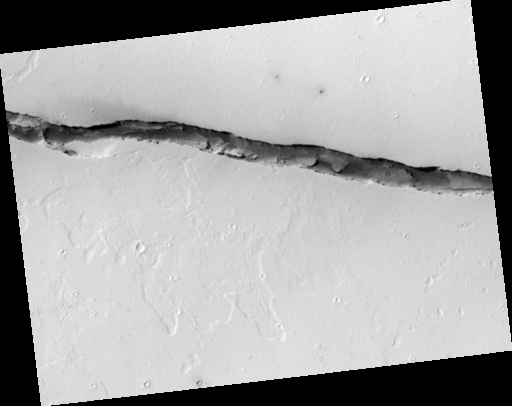Cerberus Fossae
 This color image covers only the center swath of
the full image, and is composed of images acquired through infrared, red,
and blue-green filters. The color has been enhanced to better show the
subtle color differences. It is not natural color or how it would appear
to normal human vision.
This color image covers only the center swath of
the full image, and is composed of images acquired through infrared, red,
and blue-green filters. The color has been enhanced to better show the
subtle color differences. It is not natural color or how it would appear
to normal human vision.
The prominent trough in this sub-image (of HiRISE image TRA_000827_1875_IRB ) is a segment of the Cerberus Fossae rift system. In geological terminology the trough is known as a graben, or down-dropped region bounded by faults. In this location the graben is about 300 m wide and 90 m deep. Bright, dust-covered, cratered plains surround the graben, and darker sediments blanket much of its floor. Dunes that vary in size and spacing occur within the darker sediments, and their shapes suggest that the wind typically blows from east to west. Light-toned, angular boulders pepper the darker sediments. They have broken away from the rocky walls of the graben and tumbled downhill. Over time this mass wasting has caused the cliffs to retreat, widening the trough. The somewhat lighter patches of cratered terrain on the graben floor were once level with the surrounding plains, but have since been lowered by faulting. Over time they may become obscured or buried by the darker sediments. High-standing ridges—remnants of the former surface—cast jagged shadows on the floor of the graben that reveal the rugged nature of the landscape in this region of Mars.
Image TRA_000827_1875 was taken by the High Resolution Imaging Science Experiment (HiRISE) camera onboard the Mars Reconnaissance Orbiter spacecraft on Sunday, 30 September 2006. The complete image is centered at 7.5 degrees latitude, 168.5 degrees East longitude. The range to the target site was 275.4 km (172.1 miles). At this distance the image scale is 55.1 cm/pixel (with 2 x 2 binning) so objects ~165 cm across are resolved. The image shown here [below] has been map-projected to 50 cm/pixel and north is up. The image was taken at a local Mars time of 3:26 PM and the scene is illuminated from the west with a solar incidence angle of 52 degrees, thus the sun was about 38 degrees above the horizon. At a solar longitude of 113.7 degrees, the season on Mars is Northern Summer.
 HiRISE Product ID: TRA_000827_1875_RED
HiRISE Product ID: TRA_000827_1875_RED
Images from the High Resolution Imaging Science Experiment and additional information about the Mars Reconnaissance Orbiter are available online at:
http://www.nasa.gov/mro
or
http://HiRISE.lpl.arizona.edu.
For information about NASA and agency programs on the Web, visit: http://www.nasa.gov. NASA's Jet Propulsion Laboratory, a division of the California Institute of Technology in Pasadena, manages the Mars Reconnaissance Orbiter for NASA's Science Mission Directorate, Washington. Lockheed Martin Space Systems is the prime contractor for the project and built the spacecraft. The HiRISE camera was built by Ball Aerospace and Technology Corporation and is operated by the University of Arizona.
